If you’re a regular on our blog, you’ll notice that we mention the term ‘backlinks’ a lot. After all, we’re a link building service, and backlinks are the bread and butter of one.
For anyone unfamiliar with the term, backlinks are essentially how a website vouches for another website’s credibility. In a post-Penguin SEO world, the more of these votes of confidence in a website, the higher that site goes up the search rankings. If you want numbers proving it, the graph below is from an Ahrefs study of over 900 million pages.
[caption id="" align="alignnone" width="865"]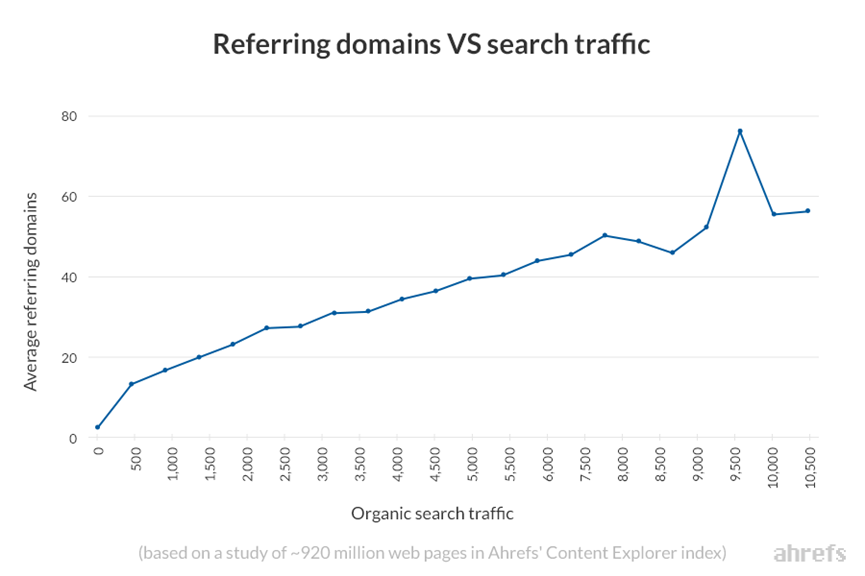 Image Source: Ahrefs[/caption]
Image Source: Ahrefs[/caption]
A website's ranking significantly improves when high-authority referring domains link to it. Imagine having The New York Times or the World Health Organization, among other reputable sites, referring readers to your content. This signifies that respected sites endorse your expertise in a specific niche.
While getting such high-authority sites to link to yours can be challenging, it's not an absolute requirement for effective SEO (although it's highly beneficial). Domain authority (DA) is an important metric, but it's not the sole one to consider. Backlinks from sites with lower DA scores that receive organic traffic can also be valuable.
You can monitor your website's backlinks using third-party tools like Ahrefs Site Explorer. Here's a screenshot displaying backlinks to the NO-BS website as an example.
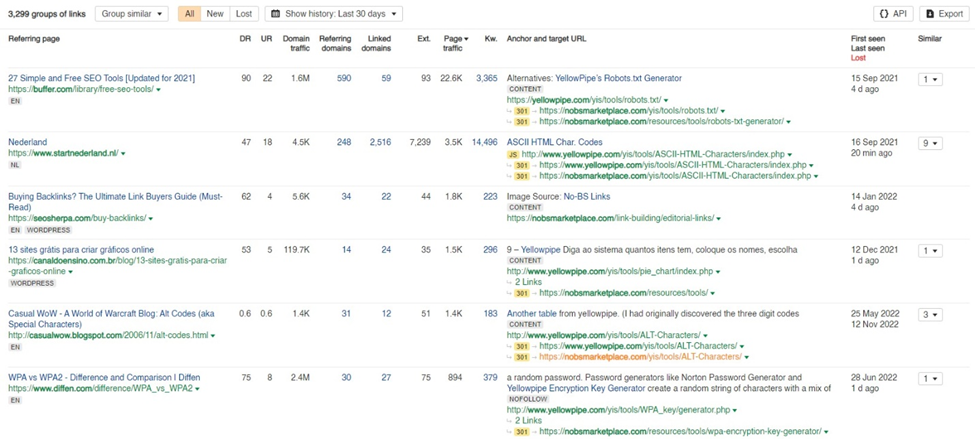
Notice that most referring pages are blog posts or articles, which makes sense. However, not all backlinks integral to a business’s SEO strategy are of this kind. Let this blog post guide you to the various must-have types of backlinks.
Dofollow vs. Nofollow
If you want to be general about the types of backlinks in SEO, they’re usually divided between dofollow and nofollow links. Dofollow links pass link equity (colloquially known as link juice) to the site, while nofollow links don’t. It can’t get any simpler than that.
But for those looking for a more in-depth explanation, this system enables Google to identify the backlinks passing authority to the linking site. The nofollow system was introduced in 2005 after many bloggers struggled with comment spam knocking more useful content out of many search results.
Down to the code, the difference can’t get any more straightforward. Dofollow links are coded as standard, while nofollow links have the ‘rel=nofollow’ tag tacked onto them.

Visitors to a website won’t notice any difference on the surface; dofollow and nofollow links can be accessed as normal. However, no matter how many visitors click the nofollow link, Google won’t factor such traffic into a website’s rankings. This feature’s useful when you don’t want particular links to make up your link profile, namely:
- Links embedded in blog comments
- Links in social media posts or entries
- Links in user-generated content (rel=“ugc”)
- Paid or sponsored links (rel=“sponsored”)
- Specific blogs and news sites
- Links embedded in widgets
- Links in press releases
You might think: ‘Why are we talking about nofollow links if they aren’t even a factor in SEO?’ That’s where it gets a bit weird. Some site admins have reported their sites’ rankings improving amid the nofollow links they have. It had been a mystery for the past decade-and-half until 2020, when Google decided to consider nofollow as a hint rather than a directive.

Although nofollow links will largely remain a non-factor in search rankings, this update implies that Google may rank nofollow links depending on their usefulness. After all, it would be a missed opportunity for a website to apply a nofollow attribute to a well-crafted piece of content with press release links or a valuable hyperlink.
Regardless, nofollow is essential in avoiding Google penalties. For example, users can report to Google any site buying or selling links, which is a violation of their spam guidelines. However, Google also says that a website link with a nofollow tag won’t be subject to penalties.
The best backlinks to have
Here’s a question: Exactly how many essential backlink types are there? SEO experts seem to be in disagreement as to the magic number, considering these search results for ‘types of backlinks.’ That’s why the title of this blog post doesn’t peg a number.
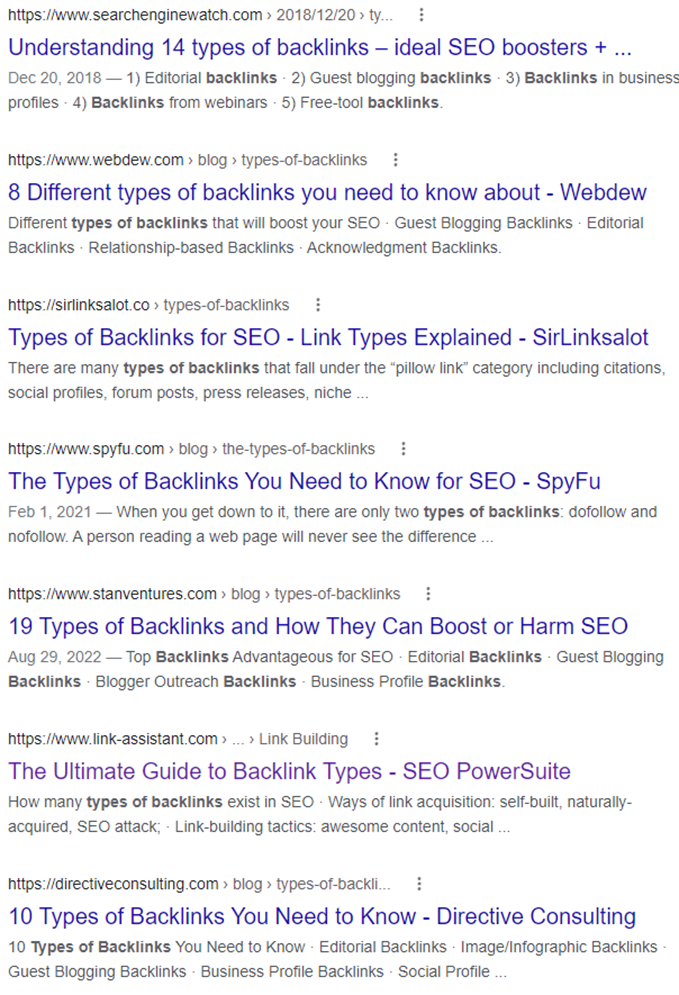
There are probably a hundred backlink types for all we know, including good and bad ones. However, not every type is required in a business’s SEO link building strategy. Most of these first-page results agree on the best type of backlinks, which are:
1. Editorial links
Arguably the most valuable, editorial backlinks are content in another website, mainly high authority ones like major news sites, that have links to your website or one of its pages. You don’t request or pay for such links; the referring domain will place one if it deems that your content is relevant and helpful.
Here’s an example: The excerpt below is from a Hubspot blog post on designing beautiful Excel charts. The anchor text in the red boxes links to NO-BS’s Colour Converter Tool.
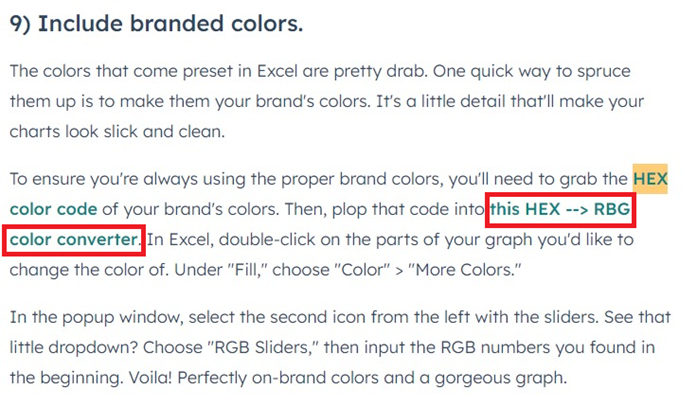
The anchor text may not link to a blog post, but this example proves that Hubspot found the tool useful. Even better, it’s from a domain with an impressive rating across the board, as far as Ahrefs Site Explorer statistics are concerned.

We’ll link the Hubspot article here, which will now serve as a backlink for Hubspot since we found it to be a good example. The more websites link such content on their respective pages, the more it convinces Google that it’s valuable content for search results.
2. Guest blogging links
The immense value editorial links provide comes at a price. Getting a high-authority website to link to your site or web page is extremely difficult, even if your blogs are worthy of a Pulitzer. Everyone wants to be recognised by a high-authority website, so those sites’ editorial teams are always swamped with requests.
Because of this, most businesses settle for the next best thing: publishers with specific niches. While most of these sites don’t get as much traffic as those for editorial mentions, they still rank in some search queries. Contributing content for these sites, known as guest posting or blogging, can generate quality backlinks of various backlink types.
The beauty of guest blogging is that its benefits work both ways. A well-written guest post can put the contributor and publisher in an advantageous position, as readers will know that they provide insightful content, increasing their reputation in the online space. Furthermore, you can find SEO tools that can assist you in identifying the most suitable anchor text and refining your link profile and linking strategy, turning your guest blogging links into a valuable resource for your website's SEO efforts.
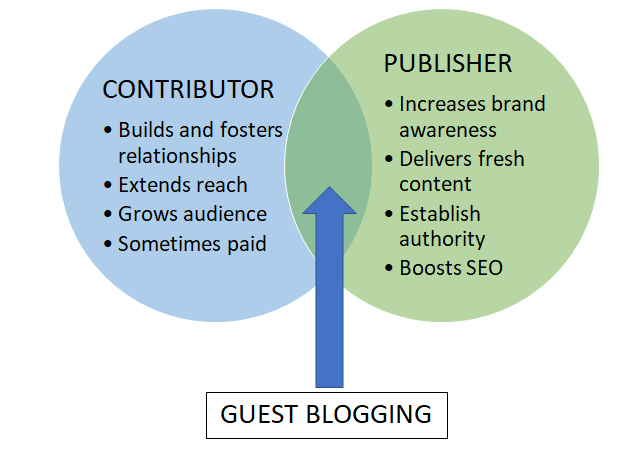
While exact numbers are hard to come by, it’s safe to say that these niche sites outnumber the high authority ones. According to Moz, getting into the top 500 websites requires a Domain Authority (DA) score of at least 92. It also points out that increasing the DA score gets harder once it reaches 70, so many sites’ scores play between 40 and 50.
In this case, getting published on a decent linking site is more important than on a site visited by tens of millions. The guest post may take a while to pick up steam, but it helps the site establish a foothold in search queries.
3. Business profile links
Though guest blogging remains a worthwhile SEO link building strategy, Google isn’t a fan of it. In 2017, it threatened web admins they could expect penalties their way if their contributed posts contained spammy links. In fact, three years prior, Matt Cutts urged people to stop relying on guest blogging to earn links.
Of course, that statement didn’t age well, and the practice remains alive and well. But you know what did? His take on social signals: social media pages, industry directories, listing and review sites, etc. At one point, he said:
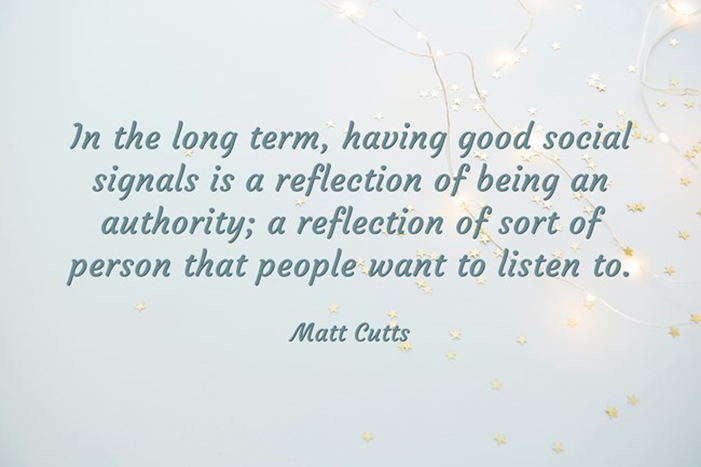
It’s hard to pinpoint when and where he said this, but it makes sense. Over half of the world’s population uses social media, spending nearly 2.5 hours daily. For businesses, social media is a gold mine of opportunities; hence, they set up pages on Facebook, Twitter, etc.
In a Q&A video in 2014, Cutts pointed out that Google crawls on social media links like any other link. However, to his knowledge, the search engine currently has no system that allows it to gauge a social media page’s ranking based on the number of likes or followers.
Even if it has the resources to develop one, it can’t risk doing so. Since Google derives data from web pages, it can risk showing personal and time-sensitive data from a user’s posts, among other things. So, when it comes to social media pages, it tends to crawl cautiously.
But if the quote above is to be believed, improving rankings isn’t the purpose of such links. Instead, they’re all about brand exposure. A business with a substantial presence on social media can appear reputable in the public eye and also Google. If people search for the name, they’ll immediately see how far-reaching their presence is.
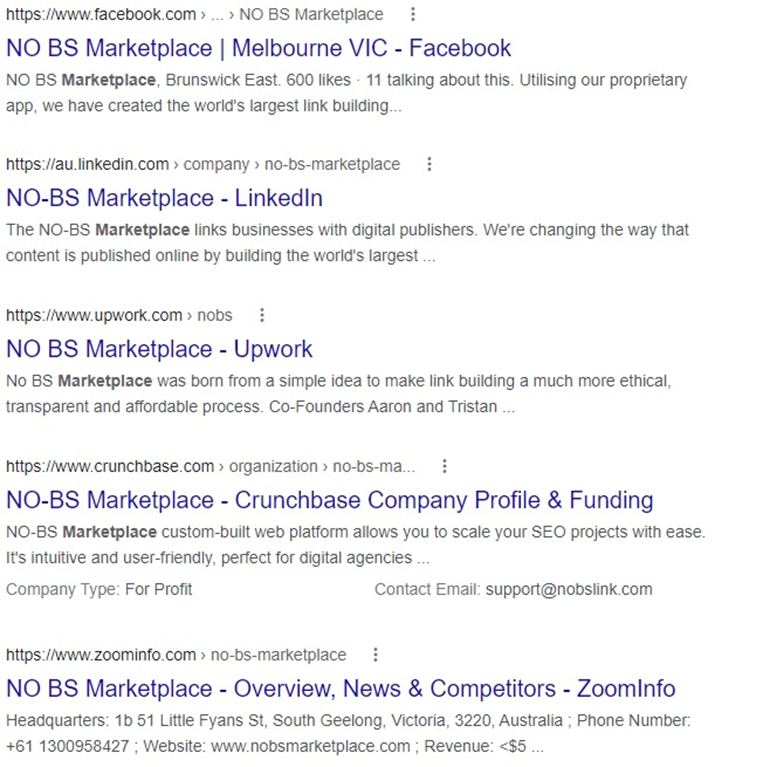
4. Free-tool links
Let’s go back to the Hubspot example from earlier. I stated that the backlink from Hubspot links to our Colour Conversion Tool. It’s also worth mentioning that you can use that tool (and every other tool in the NO-BS arsenal) free of charge.
From a marketing sense, it’s hard to beat something being offered for free. While it means that the business has to shoulder the cost, the gain in reputation, relationships, and revenue can be enough to recover any losses if done properly. The idea’s the same in boosting SEO.
Free-tool backlinks are so valuable that sometimes competitors can’t help but link your free SEO tools on their blog pages. The excerpt below comes from a post in a social media marketing firm; the link on the bottom leads to our Robots.txt Generator.
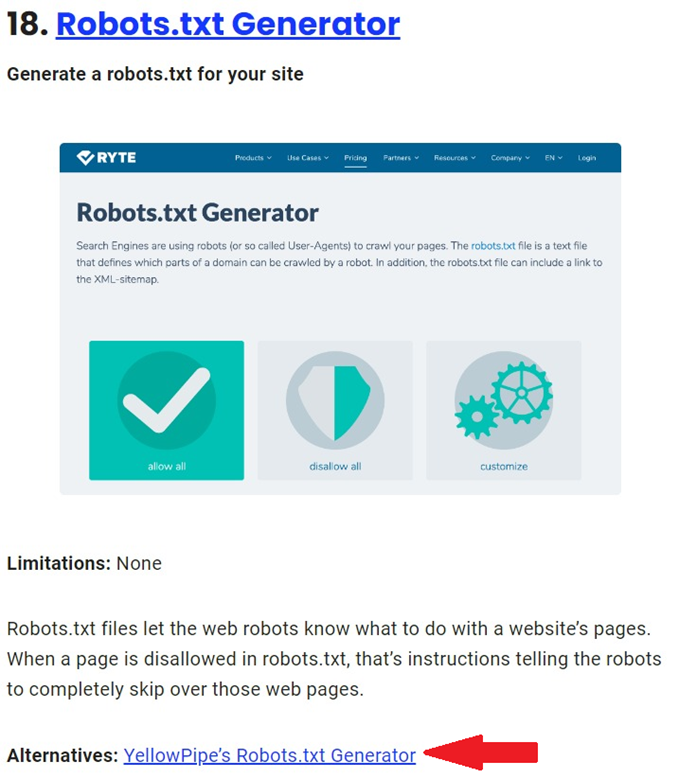
Think about it: A competitor can market their own free tools instead, assuming they have the right ones. But if they don’t have them, they’ll look to other companies that do. You’ll notice that we use screenshots from Ahrefs Site Explorer for our blog posts because the tool is a big help in making our points.
Other viable backlinks
The backlinks under this section aren’t as critical in improving a site’s SEO, but they can still be welcome additions. That said, it’s crucial to note that these types of backlinks for SEO are prone to misuse and abuse, which can lead to crippling penalties.
5. Comment links
As mentioned earlier, comment spam prompted Google to introduce the nofollow tag. Blog comments and forum replies that add little to no value to the conversation have no place in search results. People want answers, not shameless self-promotions.

Comment spam is as bad for the site with the comment as the offending commenter. Neil Patel explains that comment spam gives off the impression of allowing spam to fester on the site. Additionally, visitors will lose faith in the site if the comment links lead to irrelevant or low-quality pages.
When used correctly, however, comment backlinks can be valuable. One viable approach is to answer industry-relevant questions on sites like Quora. In the example below, an industry expert for a link building firm answers a user’s question on what link building is in detail and provides a link to the firm’s blog post at the bottom.
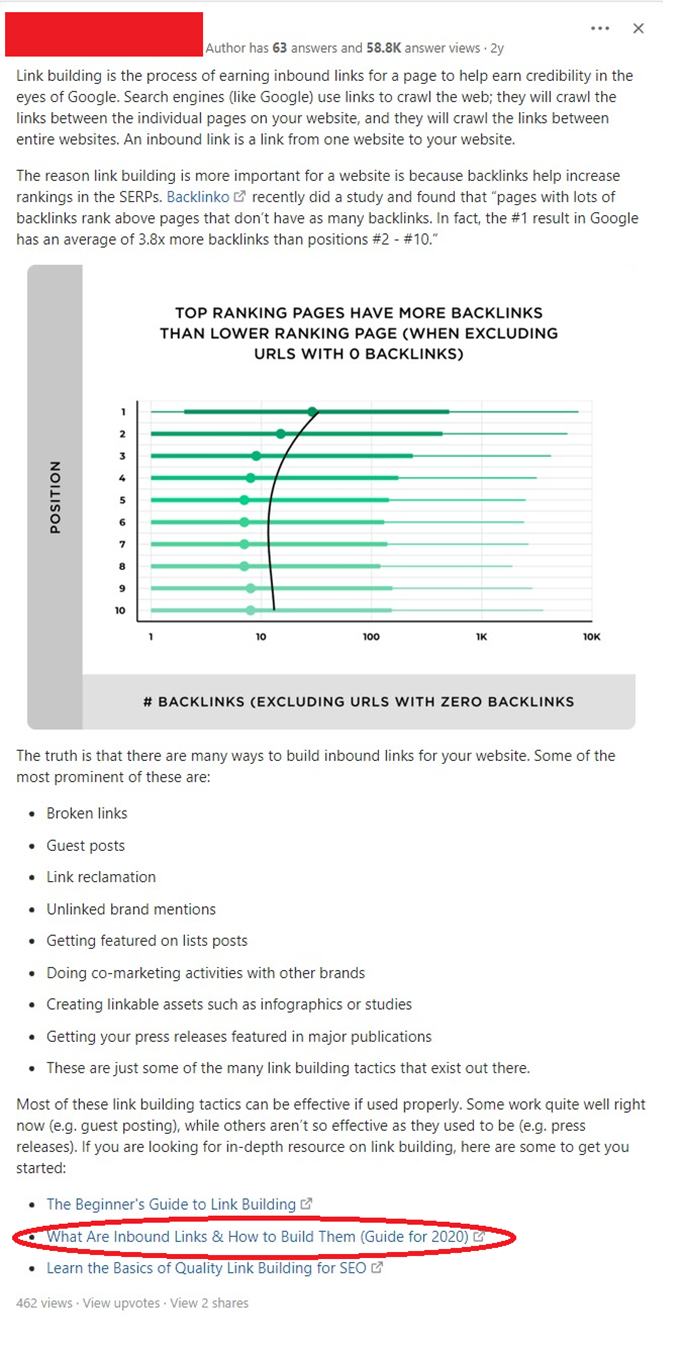
The encircled link is the only one that leads to the answer author’s site. The rest lead to other online resources, such as Backlinko, Moz, and Wordstream. The diverse references it contains make the answer appear less like an advertisement and more like a professional’s insight.
6. Newsworthy press release links
Press releases are a business’s tool of choice for creating a favourable narrative, establishing relationships with the media, and increasing customer engagement. The latest statistics from Cision’s State of the Press Release 2021 report that 36% of businesses release more than 10 press releases annually.
The results of such releases fulfill the purposes mentioned. They establish the business as a thought leader or an authoritative source and help build better relationships with reporters. However, press releases don’t do much to attract new customers—and current SEO doctrine may have something to do with that.
Besides buying and selling links, Google penalises over-optimised anchor texts in guest posts and distributed press releases. Google provides an example below.
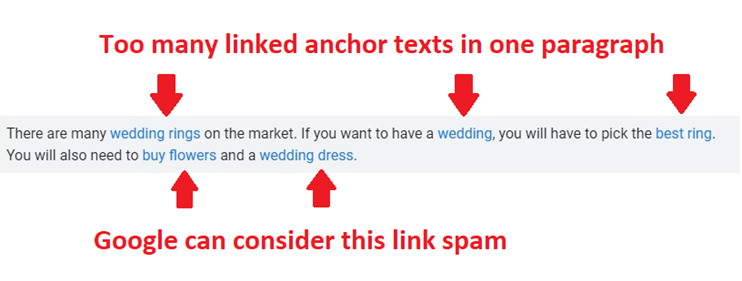
Another potentially penalising aspect is that the press release isn’t newsworthy enough. Any press release published these days should be unique enough to catch the eye of reporters and the public. If your clothing business is announcing a new pair of pants made from recycled bottles, what makes it different from the dozens of others already doing it?
For the record, as with guest blogging, press releases are still acceptable ways to generate backlinks. However, don’t expect them to attract as many new customers as other marketing methods. Instead, it boils down to the press release’s original purpose: establishing authority in a specific industry.
7. Author bio links
Not all guest-written content warrants an author bio. Experts say author bios are only ideal if you already have a team of credible content creators and a sizeable reader base. Author bios are also practical for Your Money, Your Life (YMYL) topics, such as healthcare and finance.
If your business meets the conditions for an author bio, know that they don’t influence SEO in any way. John Mueller, Google’s Webmaster Trends analyst, made that clear in a Q&A video published in 2019. He cites that author bios aren’t necessary for improving rankings, and their use should depend on how their customers perceive them.
Instead, focus on more effective linking and link exchange ways to enhance your website's SEO.
If you still want that author bio after this, experts recommend not going overboard with the links, lest you earn Google’s ire. There’s no ideal number of links, but most experts agree that between one and three is acceptable. Here’s an example from one of my guest articles.

Here’s another example from Neil Patel. His author bio has three links.
[caption id="" align="alignnone" width="896"] Image Source: Neil Patel[/caption]
Image Source: Neil Patel[/caption]
Some experts recommend the business name or its content team as the byline, as there’s much equity to be lost if the author decides to leave the company. A fact checker byline (commonplace in health articles) adds to the byline’s authenticity.
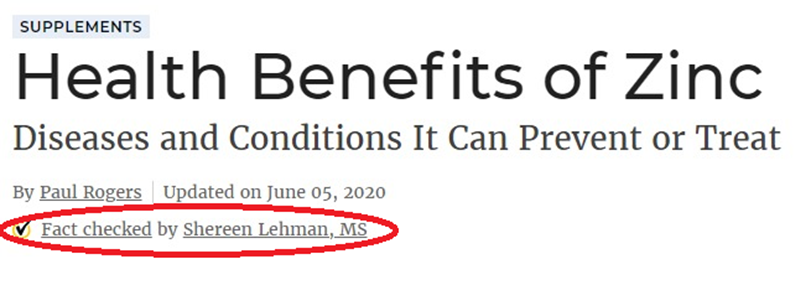
8. Acknowledgement links
Assuming you’ll be a speaker or sponsor, webinars and other events can be great sources of backlinks. Information about a webinar, conference, or charitable event, among other things, will sometimes link to the speaker or sponsor’s site or profile.
[caption id="" align="alignnone" width="975"]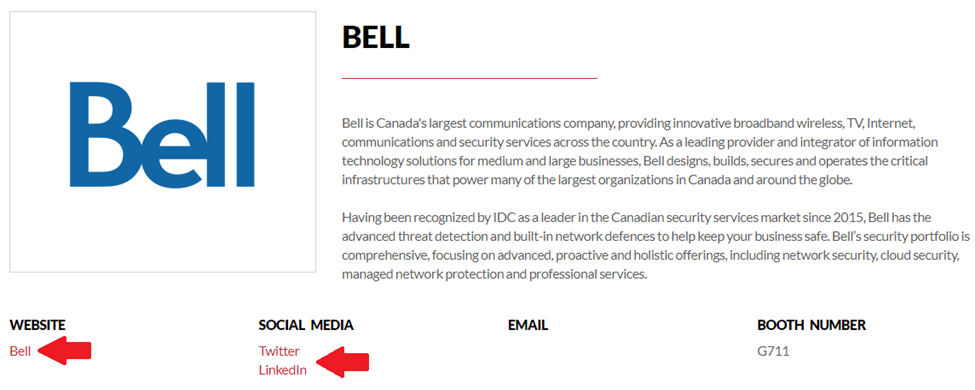 Image Source: Bell[/caption]
Image Source: Bell[/caption]
Emphasis on ‘sometimes,’ as not all opportunities result in acknowledgment backlinks. The example below is from a content strategy conference scheduled for next year. Notice the lack of backlinks in the profile.
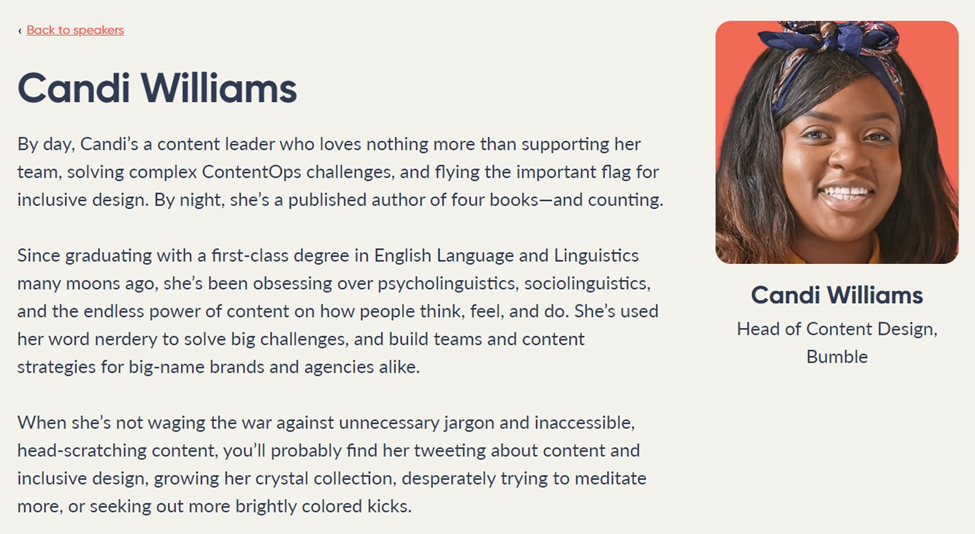
Whether or not the site of opportunity provides backlinks, being a speaker or sponsor helps with brand exposure, just as press releases do. Attendees and other visitors may be inclined to find more information about the business, given that it’s reputable enough to be a resource speaker at a conference.
Conclusion
As for the remaining backlink types, they might not make any major difference in any SEO strategy or should be avoided entirely. Web admins should focus their time and resources on earning backlinks from high-authority and niche sites, social media and directory pages, and free online tools. Other resources, such as press releases, comments, author bios, and speaker or sponsor profiles, can augment a backlink profile, but don’t count on them to contribute significantly to your web pages.
Selecting the right backlink types is crucial, but integrating them effectively into an SEO strategy is equally important. If you're interested in successful link building, explore our link building packages. We work with agencies and in-house marketing teams to ensure the effectiveness of their strategies.
